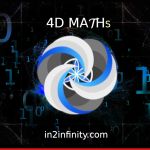Okay, so I hope that’s fairly clear about the infinite structure as we move through the infinite to discover the structure of mathematical space from the logical construct, which is what is important is important that we structure numbers properly. Otherwise we don’t have a proper understanding of their root. We can never really understand their true nature. So moving on, what we have discovered is, is that the first thing the mathematics does is divide. It doesn’t subtract, it doesn’t add. There’s no such thing when you come to infinity. All we have is the function of dividing dividing infinity. That’s the only thing we can do with infinity is divided. But once Infinity has been divided, we give rise now to another three options, one from the first step when we take the second step. Now, we now have three options extra, that means a total of four options. We’ve gone from one singular type of mathematical operator as an option to now three, at effort. Step number two, that’s why we calculate things in terms of efforts that we can keep track of the ordinal numbers. So we’ve gone now to from zero, we’ve made the first step sorry, which is effort number one, which is to divide infinity. From that we created the ratio infinity two to infinity minus two for the Cardinals and ordinals respectively. From that, then we go to the next step, which is E two and E two is the effort step two, where we can suddenly have the functions of multiplication. We can divide again, we can also plus and minus, as plus and minus two tend to appear as actually opposite functions of each other on a single number line as we have discovered from the infinite structure and step II one. Therefore, we can say that we can piece those together as one function plus or minus. And when we go plus or minus one, we’ve understood that it terminates the infinite number line of cardinal numbers, and that’s how the structure works. Therefore, we can also have now that we have this zero plus or minus zero. And when we think about it, what that does is that will take us back to zero neutral, zero neutral then we’ll call it we call zero we normally write it as a capital letters zero, like this. Zed e r o like that. That way we can distinguish it from the plus and minus zero. So if we plus or minus zero, we can understand we can shrink back to zero we can collapse zero back down and collapse the Infinity back down to zero. I divide everything Yeah, but we would need to apply that to zero at either side simultaneously, but when we do the called simultaneous calculation, we collapse the plus and the negative zeros into the neutral, zero neutral zero. Yeah. So all clear, very good. So we could also say that we reimburse the process Yeah, we will take a step towards the number one, therefore, you can see how that works. And that will lead us into the steps of creation of infinity. Yep. And then we will create the cardinal numbers up into whatever infinite point we decide until we decide to minus one and then the total of that infinity will be apparent, and we will have that number reduced in the cardinal form. So the next step then is to find out what else we can do e to the F at number two, obviously, we can find the square root of zero which would mean dividing zero yet again. And if we do we find that actually, we actually look back at the original infinite density, we find the if we divide into that actually infinite density will become the square root of two with to the relationship of infinity minus the square root of two, because we’re square rooting, if we square root the number two, for example, we will get the square root of two. The square root of number one will get the square root of number one, a square to number zero, but because when we elevate in mathematical infinity, we can understand that the scale of square root of two infinity plays a very significant role, particularly when we come to the next stage, which is very important, called zero squared. So the square root of zero now sets the infinite density to a ratio square root of infinity to infinity minus the square root of two for the cardinal and ordinal numbers respectively. Now we have set the stage for zero squared to emerge.
When we take the number zero, we often think that we cannot do anything mathematical with the concept. However, from the perspective of infinite mathematics, this is not the case. As we have a positive zero and a negative zero quite clearly. Both can be multiplied together in a squaring function to create a new kind of zero. So if we multiply a negative zero, with a positive zero, what we get is another negative zero. So it can’t be that that can be the that’s a product of those two things. So it can’t be the same thing. And therefore we have to do is we have to find a new space on the number line for negative zero, which comes out emerges out of the zero squared. In order to do that, what we do is we rotate the number line in a anti clockwise direction because of that function. And due to the fact that is an anti clockwise rotation. That means that the positive zero will naturally arise to the vertical position opposite the negative zero, and this creates a quadruple function of zero with 0x zero y in the, in the zero lines, each exhibiting a positive and negative with the zero at the scent centre. But all we need to know is that we only needed to perform that function on one quarter of the of the of the overall structure to form the complete structure itself. And that quarter contains what we call pi divided by four or a quarter pie. We will look more into these into the details of all of that you can see that as we swing the zero round there, it creates a nice arc. You can see that all points are from between one zero to the other. Zero will remain exactly the same ratio. And what we’ve done is now we’ve just introduced the third type of number categorization, which we call the geometric ratios. And the thing about geometric ratios is that we are always able to collapse any cardinal number into these geometric ratios by performing what we call the bounce point calculation. We will talk more about bounce points in future presentations as we move into infinity and the informatics and the fourth dimensional mathematics of infinity proposed by the structure of numbers that we are talking about today. So everything will good on the idea here that we have as we can just sum it up very simply now, we have a structure of number space with zero neutral at the centre. We have two number lines and X and Y number line with a positive zero and a negative zero and a positive zero and a negative zero, which create a number number surface now, which is constructed from a rotational function. So we can show that that then becomes a cross in a circle. And that is the definition of that of that structure, mathematically, and we can just place the zeroes positive negatives and the x and y’s in the right place. And we have our map of the infinite and then we know how to move on that map because we can collapse into zero by hitting the square root we can collapse into the square root of zero, or collapses to the zero point. And at the same time, we know that we can square the zero to create this structure. And so actually, what happens is with simultaneous calculations, and the fact that all of this comes from the quad cardinal number number two the effort step number two where we have a decision, we can make a civil taneous decision in time, which means that actually we have three decisions we can make. We’ve made those three decisions, and the result is a square with zero that can claps into a zero point and expand into a square from a number line. And it is that function of mathematics, which is the combination of the four mathematical ombre operandi upon which all other mathematics is based. And now all we need to do is find out where is the square root of one, which we will go into next.


